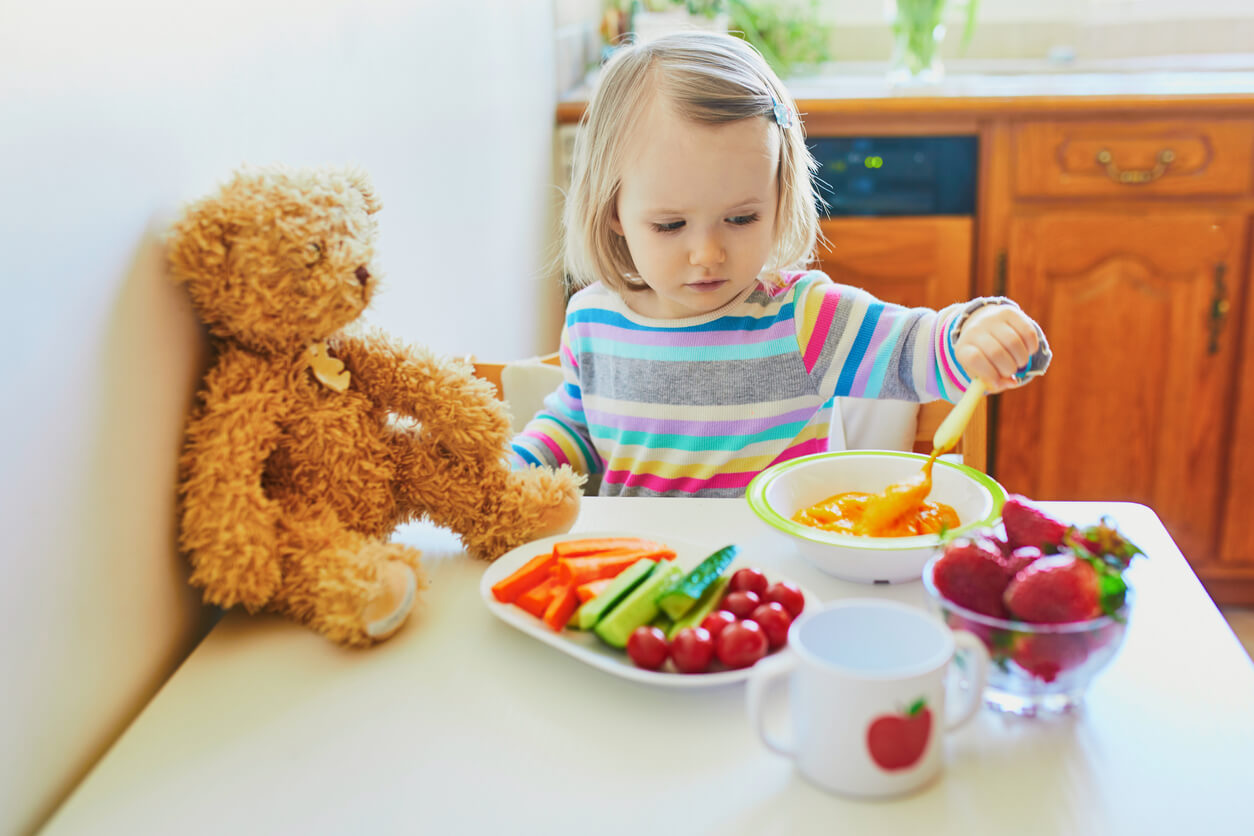The Effect of Colors on Babies


Written and verified by the psychologist Elena Sanz Martín
When a baby’s born, a whole process of learning and brain development begins that will continue at a dizzying pace during the first years of life. And in this process, colors play a fundamental role. They’re one of the first elements with which little ones will experience the sense of sight. In addition, colors will become great allies to help them to know and understand the environment around them. For all of these reasons, we want to talk to you about the effect of colors on babies.
Surely, you’ve noticed that the spaces and objects intended for infants are usually colorful, bright, and vibrant. And this is no coincidence. The truth is that colors stimulate cognitive development, influence mood, and are a great facilitator of learning. But what role do they play? And how can we use them appropriately? We’ll explore the answers below.
Color perception and its evolution
During the first months of life, the sense of sight develops and sharpens. Colors are fundamental in helping babies achieve this. Let’s keep in mind that during the first three months of life, infants perceive what they see in a blurred way and only in black and white. They don’t yet perceive color, but have a great capacity to identify details and differences due to lighting. For example, they may be attracted to the color red because of its brightness.
Up to the age of six months, it is contrasts that will help perceptual development the most. And babies will find striking those changes in tone colors.
Learn about the effect of colors on babies
Beyond the baby’s progressive ability to capture, recognize, and distinguish between colors, we’ll tell you what some of the benefits they bring to their development are.

Neural connections and learning
When we’re babies, we have a large number of neural connections, but as we grow, synaptic pruning occurs. That is, a process of refinement that allows us to keep the most useful connections and strengthen them.
In this process, colors help children and allow them to be interested in what they see in their environment so they feel more encouraged to interact with objects.
Discrimination of objects and vocabulary
Colors and the differences and contrasts between them are an aid in able for babies to discriminate when their sense of sight isn’t yet well developed. But also, later on, as children tend to associate them with objects in order to recognize them easily. For example, the sky is blue, the sun is yellow, and apples are red. These connections help in the identification of objects and also favor an increase in vocabulary.
Memorization
The effect of colors on babies is also related to their memory capacity. Infants remember colors better than verbal cues. Therefore, using colorful images can make it easier to learn and remember content.
Identity building
Beyond the intellectual level, we also find a beneficial effect in terms of identity building. In this regard, once the child’s able to identify colors, name them, and understand their associations, they can begin to choose and develop their tastes and preferences.
Having some favorite shades and selecting them in their clothes, toys, or belongings helps to strengthen their sense of individuality and begin to build part of their personality. Also, you can discard those colors they like the least, among other simple actions and decisions.
Mood
At the same time, colors have an effect on a child’s emotional state and this is something that can be positive or negative. Certain shades induce calm and serenity, while others stimulate and encourage learning. Also, some are distracting and others encourage creativity.
Therefore, it’s important to make good choices and combinations in children’s environments in order to achieve the desired goals. For example, a nursery or playroom shouldn’t have the same tones as their bedroom, as the functions for which they’re used are very different.

Eating habits
Finally, colors can be excellent allies in establishing good eating habits. For example, it’s common for babies to be reluctant to try or accept certain foods. However, preparing them in attractive ways by combining and highlighting their natural colors can make them much more appealing to little ones.
How to stimulate babies with colors?
With all the above in mind, we conclude that colors have great potential to promote the cognitive, emotional, and social development of babies. Therefore, we have to use them wisely.
The key point is to make sure that the child’s exposed to different shades and their contrasts in their daily environments. Buying eye-catching mobiles, decorating play areas in warm tones, and combining a variety of colors in everyday life will help to stimulate your baby. This will awaken their interest and promote proper development.
When a baby’s born, a whole process of learning and brain development begins that will continue at a dizzying pace during the first years of life. And in this process, colors play a fundamental role. They’re one of the first elements with which little ones will experience the sense of sight. In addition, colors will become great allies to help them to know and understand the environment around them. For all of these reasons, we want to talk to you about the effect of colors on babies.
Surely, you’ve noticed that the spaces and objects intended for infants are usually colorful, bright, and vibrant. And this is no coincidence. The truth is that colors stimulate cognitive development, influence mood, and are a great facilitator of learning. But what role do they play? And how can we use them appropriately? We’ll explore the answers below.
Color perception and its evolution
During the first months of life, the sense of sight develops and sharpens. Colors are fundamental in helping babies achieve this. Let’s keep in mind that during the first three months of life, infants perceive what they see in a blurred way and only in black and white. They don’t yet perceive color, but have a great capacity to identify details and differences due to lighting. For example, they may be attracted to the color red because of its brightness.
Up to the age of six months, it is contrasts that will help perceptual development the most. And babies will find striking those changes in tone colors.
Learn about the effect of colors on babies
Beyond the baby’s progressive ability to capture, recognize, and distinguish between colors, we’ll tell you what some of the benefits they bring to their development are.

Neural connections and learning
When we’re babies, we have a large number of neural connections, but as we grow, synaptic pruning occurs. That is, a process of refinement that allows us to keep the most useful connections and strengthen them.
In this process, colors help children and allow them to be interested in what they see in their environment so they feel more encouraged to interact with objects.
Discrimination of objects and vocabulary
Colors and the differences and contrasts between them are an aid in able for babies to discriminate when their sense of sight isn’t yet well developed. But also, later on, as children tend to associate them with objects in order to recognize them easily. For example, the sky is blue, the sun is yellow, and apples are red. These connections help in the identification of objects and also favor an increase in vocabulary.
Memorization
The effect of colors on babies is also related to their memory capacity. Infants remember colors better than verbal cues. Therefore, using colorful images can make it easier to learn and remember content.
Identity building
Beyond the intellectual level, we also find a beneficial effect in terms of identity building. In this regard, once the child’s able to identify colors, name them, and understand their associations, they can begin to choose and develop their tastes and preferences.
Having some favorite shades and selecting them in their clothes, toys, or belongings helps to strengthen their sense of individuality and begin to build part of their personality. Also, you can discard those colors they like the least, among other simple actions and decisions.
Mood
At the same time, colors have an effect on a child’s emotional state and this is something that can be positive or negative. Certain shades induce calm and serenity, while others stimulate and encourage learning. Also, some are distracting and others encourage creativity.
Therefore, it’s important to make good choices and combinations in children’s environments in order to achieve the desired goals. For example, a nursery or playroom shouldn’t have the same tones as their bedroom, as the functions for which they’re used are very different.

Eating habits
Finally, colors can be excellent allies in establishing good eating habits. For example, it’s common for babies to be reluctant to try or accept certain foods. However, preparing them in attractive ways by combining and highlighting their natural colors can make them much more appealing to little ones.
How to stimulate babies with colors?
With all the above in mind, we conclude that colors have great potential to promote the cognitive, emotional, and social development of babies. Therefore, we have to use them wisely.
The key point is to make sure that the child’s exposed to different shades and their contrasts in their daily environments. Buying eye-catching mobiles, decorating play areas in warm tones, and combining a variety of colors in everyday life will help to stimulate your baby. This will awaken their interest and promote proper development.
All cited sources were thoroughly reviewed by our team to ensure their quality, reliability, currency, and validity. The bibliography of this article was considered reliable and of academic or scientific accuracy.
- Rua, M., & Calucho, M. (2017). Guía de Contenidos- Estimulación temprana de niñas y niños de 0 a 6 años. Consorcio PROCOSI/CEMSE. Recuperado 2021, de https://formaciontecnicabolivia.org/sites/default/files/publicaciones/guia_cuidado_de_ninos_y_ninas_
- Yang, J., Kanazawa, S., Yamaguchi, M. K., & Motoyoshi, I. (2015). Pre-constancy vision in infants. Current Biology, 25(24), 3209-3212.
This text is provided for informational purposes only and does not replace consultation with a professional. If in doubt, consult your specialist.








